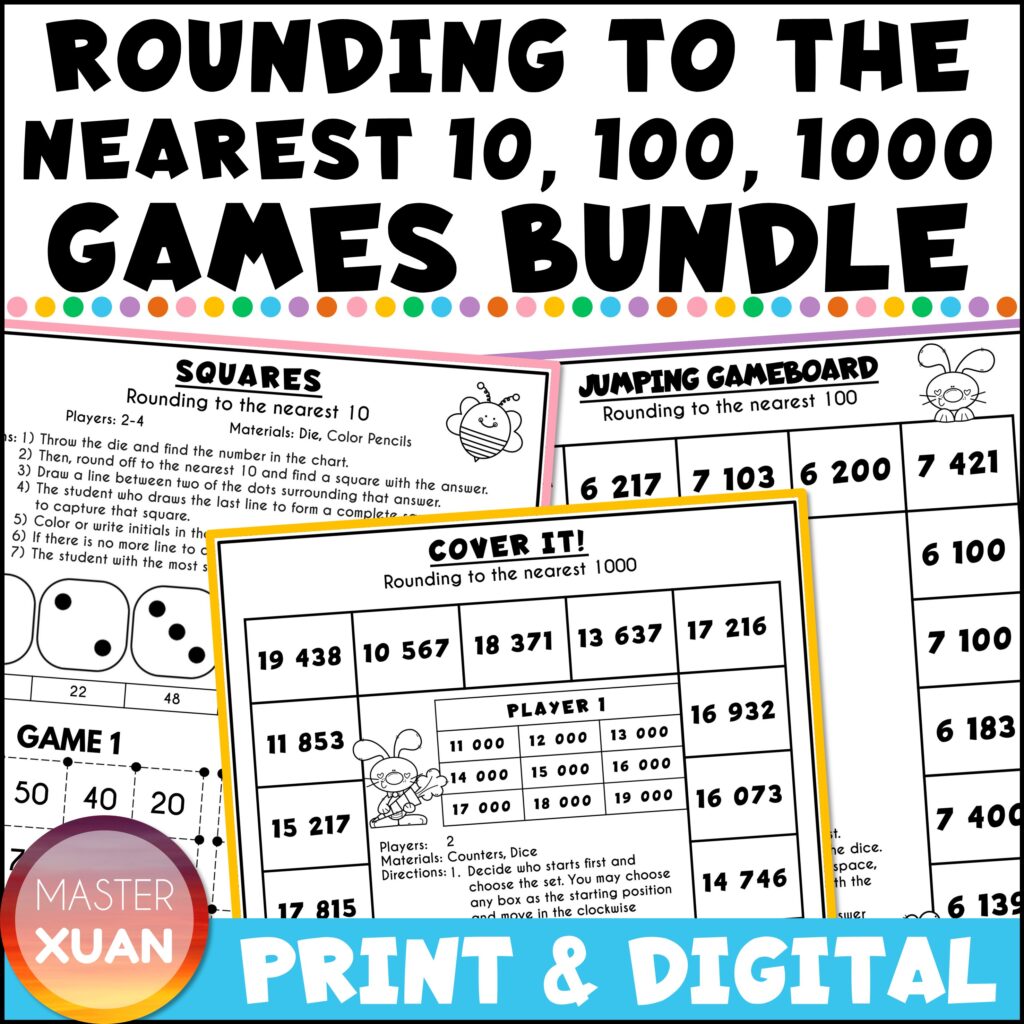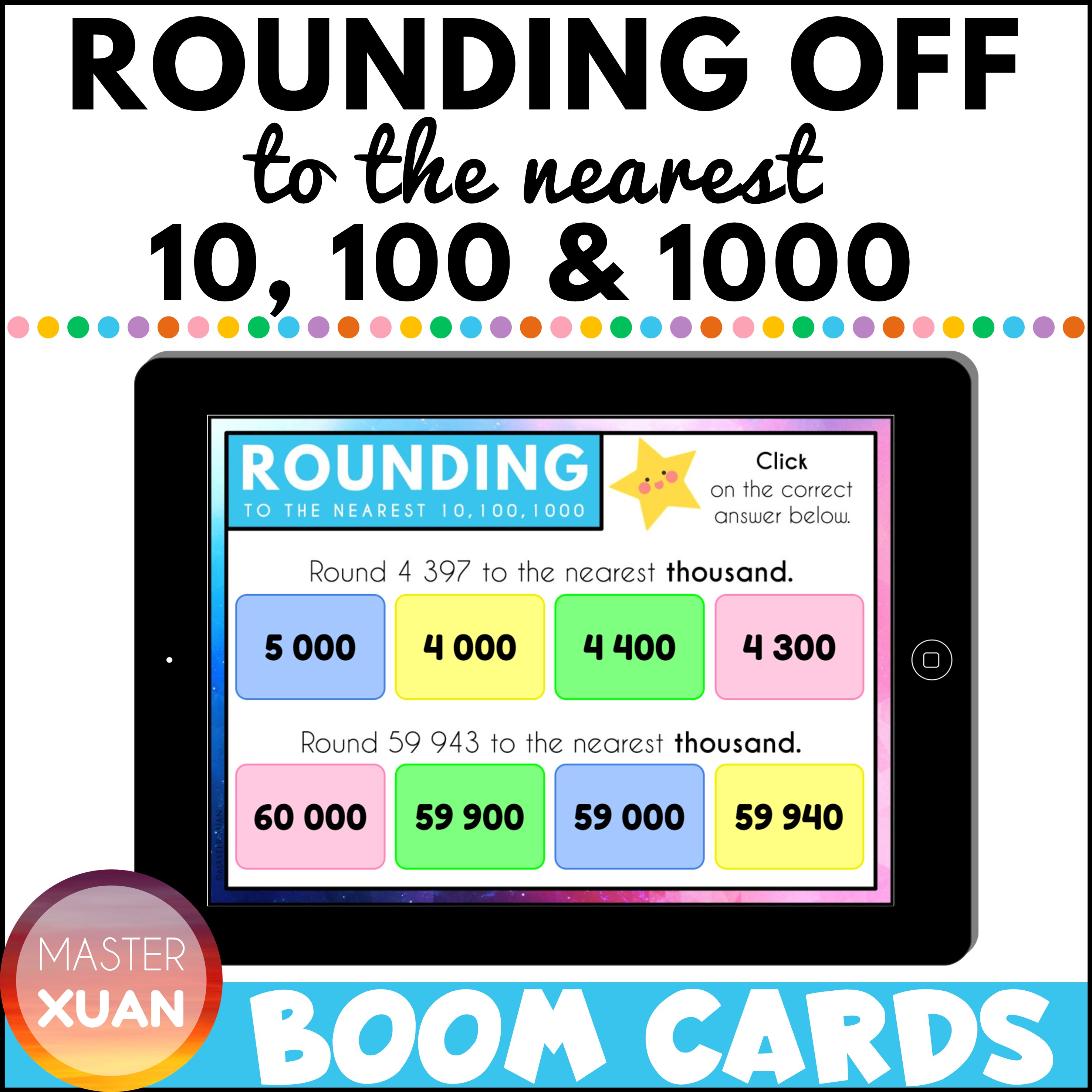In this blog post, I’ll show you how to teach rounding numbers in 5 different ways.
Teaching students the skill of rounding numbers is crucial as it helps them understand how to estimate and how to make numbers easier to calculate.
This skill builds upon their prior knowledge of place value. By the time students reach third grade, they are expected to have a solid understanding of whole numbers and the value of tens and ones.
In fourth grade or Singapore Primary 4, students are introduced to rounding numbers to the nearest tens, hundreds, or thousands.
While it may be tempting to directly delve into the technical steps of rounding off, it is crucial to resist this temptation and prioritize building a solid conceptual understanding of the rounding process.
Throughout this blog post, we will explore various methods for teaching rounding numbers to fourth and third graders.
1) Discussion about the use of rounding off
To capture students’ attention and help them understand the logical reasoning behind rounding off, I like to begin with real-world examples.
I like to use numbers that end in 9 and ask them to make a choice.
For instance, if you bought something for $19, would you tell your friend you bought it for $10 or $20?
Similarly, if your score is 49, would you tell your parents you scored around 50 or 40?
By discussing these scenarios, students start to grasp the situations where rounding off or estimation is applicable.
Then, I’ll ask them in what situation they will use rounding off or estimation.
After having that discussion, we will move on to rounding down and explore when to round up and round down.
Instead of telling them the answer, I’ll show them a video. This brings us to the next step.
2) Watch an animated video to introduce rounding off
Numberocks offers a variety of animated videos that introduce mathematical concepts, one of it is the Rounding Numbers Song | 3rd Grade – 4th Grade.
However, simply watching the video isn’t enough. Students might view it as mere entertainment and forget its purpose as a learning tool.
To ensure their engagement, I inform them beforehand that I will be asking questions about the video. This prompts them to pay attention to the details.
After showing the video, I will ask them questions such as:
- Why do we round off? What is the purpose of rounding off?
- If we round off to the nearest hundreds place, for example, 284, which number do we need to look for to determine whether we round up or round down?
- What is the rounded number?
- When do we round up? When do we round down?
- What do we do at the halfway point?
3) Use a number line
Using an open number line is an effective way to illustrate the relationships and distances between numbers.
To help students remember that the digit 5 requires them to round up, I like to tell my students this scenario:
I ask them to imagine the smaller number as their home and the larger number as their school. When they’re halfway on their journey and need to use the washroom, do they run back home or continue to the school they’re headed to?
By presenting this analogy, students gain a better understanding of the comparison involved in rounding off.
I use this great resource Rounding Off To The Nearest 10 And 100 to let them have a better understanding of what they are actually comparing.

4) Play games
Playing games is an enjoyable way to reinforce learning and encourage peer-to-peer interaction. It’s remarkable how much faster students grasp concepts when they’re engaged in play.
There are three similar resources featuring games that target different math skills:
- Rounding To The Nearest 10 Games
- Rounding To The Nearest 100 Games
- Rounding To The Nearest 1000 Games
You can choose the resource that best suits your students’ needs or acquire all three at a discounted rate: Rounding to the Nearest 10 100 and 1000 Games.

Key Features:
✅rounding numbers to the nearest 10 100 and 1000
✅27 Gameboards
✅9x Partner Games
✅18x 2-4 players Games
✅Spring Theme
✅2 Recording Sheets for Accountability
✅Answer Key for selected games
✅Fun & Engaging
✅No Prep!
✅Economical to print: Black & White
✅Digital Option: Easel

Once you are done with pairs or small group games, it is time to play as a class!

Key Features
- 6 Bingo Sets = 150 questions
- 2 types of game boards
- 6 pre-made Bingo Cards for each set
- 1-page cut & paste bingo cards per set
- 1 empty game board
- Spinner for partner game
- Answer key
- Valentine’s Day or love-related holidays like Mother’s Day
- 2 Formats: Printable, Easel
- No Prep
- Fun & Engaging
- Economical to print: Black & White
- Singapore Primary 4 | 3rd & 4th Grade
5) Quiz or practice with Boom™ Cards
Boom Cards can engage students and allow for individual practice and assessment. With the use of self-checking digital task cards, life is so much easier.

Transform your learning experience with this engaging star-themed deck of 30 boom cards, perfect for quizzes, homework and practice sessions.
These cards will effectively assess and enhance your students’ skills in rounding off numbers with two to five digits to the nearest ten, hundred, and thousand.
Included are 1 notes card and 7 different question types, featuring a total of 2 interactive formats: fill in the blanks and multiple-choice.
With this easy to use resource, you can enjoy an interactive and effective way to reinforce these math skills.
Personally, I use this as a practice for my students. Exposing them to different question types helps them gain a better understanding of the concept.
Final Thoughts
In conclusion, teaching students how to round numbers is an essential skill that builds upon their understanding of place value and number sense.
By using a variety of methods such as discussion, video, number line, games, and Boom Cards, teachers can help students develop their rounding skills.
With a strong understanding of rounding rules, students can confidently round numbers and arrive at the correct answer.
However, it’s important to note that learning a skill doesn’t end once we’ve covered the topic.
Regular review helps to keep the skills fresh in students’ minds.
Moreover, when we eventually introduce rounding off decimals in the future, we can revisit and reinforce these rounding skills.
Remember, teaching doesn’t have to be boring!
Using engaging activities can make a significant impact on students’ understanding and enjoyment of the subject.
Related Read: 3 Easy Steps To Help Students Really Understand Rounding With Decimals Now
Here are some pins that you can save to bookmark this post. Save them to your Pinterest Board now! ↓







